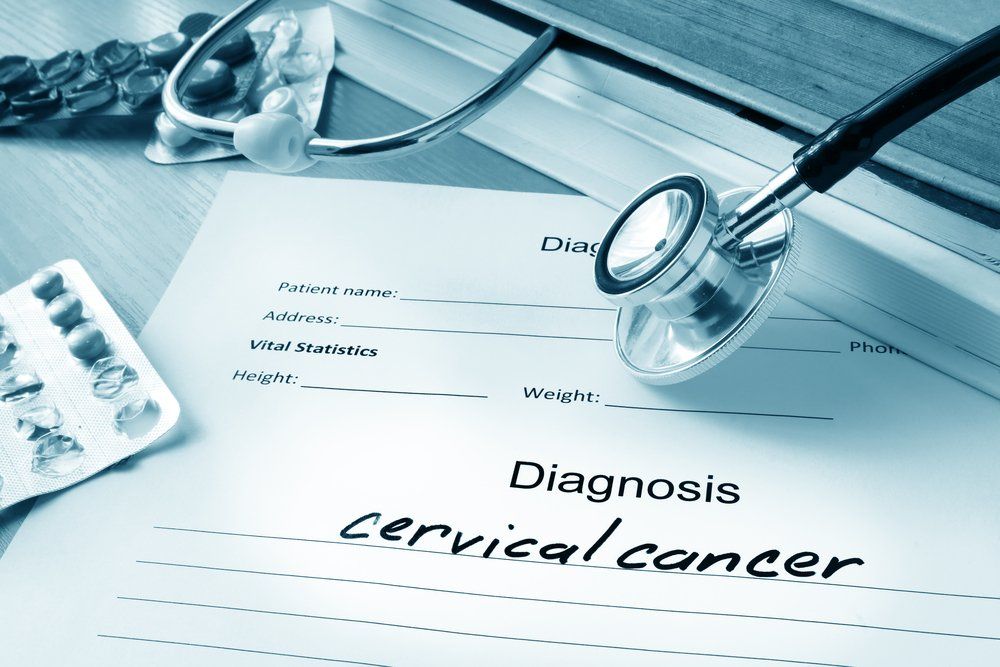Does minimally invasive surgery for cervical cancer = longer survival?
While minimally invasive and open surgeries have been found to produce similar survival rates in other early cancers, that might not be the case for early cervical cancer. PLUS: At what age should cervical cancer screening stop? ALSO: How much do genetic variants affect breast cancer risk?
©Jacob Lund - stock.adobe.com

For early uterine, colorectal and gastric cancer, minimally invasive and open surgeries have been shown to produce similar survival rates. Results of a new cohort study suggest that the same may not be the case for early cervical cancer.
Published in The New England Journal of Medicine, the analysis involved a cohort of more than 2,000 women who underwent radical hysterectomy at Commission on Cancer-accredited hospitals in the United States. The procedures were done between 2010 and 2013 for stage IA2 or IB1 cervical cancer. Of the surgeries, 49.8% were minimally invasive and 50.2% were open.
The research was designed to determine how minimally invasive surgery affected all-cause mortality in women undergoing radical hysterectomy for cervical cancer. The patients had undergone different procedures but were similar with respect to other measured characteristics. Using the Surveillance, Epidemiology, and End Results program database, an interrupted time-series analysis also was conducted involving women who underwent radical hysterectomy for cervical cancer between 2000 and 2010.
Over a median follow-up of 45 months, 4-year mortality was higher in the women who had minimally invasive surgery than in those who had open surgery (9.1% vs 5.3%; hazard ratio, 1.65; 95% confidence interval [CI] 1.22 to 2.22; P = 0.002 by the log-rank test). Women who had the minimally invasive procedures were more likely to be white, privately insured and from ZIP codes with higher socioeconomic status. They were also more likely to have had the surgery in the Northeast and South and at nonacademic facilities. Their tumors tended to be smaller and lower-grade and to have been diagnosed later in the study period than the ones in the women who had open procedures.
Of the minimally invasive surgeries performed on the cohort, 79.8% were robot-assisted laparoscopy. However, use of the device did not change the association between all-cause mortality and route of hysterectomy for early-stage cervical cancer. The authors hypothesized that patient selection or confounding may have contributed to the survival results. They noted that their results differed from previous reports but said the study was larger and had longer follow-up than the earlier trials.
The fact that they could not explain why minimally invasive surgery was associated with shorter survival, the researchers said, was an important limitation. They speculated that the extent of resection may be inherently limited in a minimally invasive procedure or that uterine manipulators may disseminate tumor cells. Surgeon experience also may have played a role if the surgeons who did the open procedures in the women in the cohort were more experienced than were the ones who did the minimally invasive procedures.
The authors noted that adoption of minimally invasive surgery coincided with a decline in the 4-year relative survival rate of 0.8% (95% CI, 0.3 to 1.4) per year after 2006 (P = 0.01 for change of trend). In contrast, from 2000 to 2006, the 4-year relative survival rate for women who underwent radical hysterectomy for cervical cancer was stable.

At what age should cervical cancer screening stop?
Cervical cancer incidence and mortality are high in older women and guidelines for the age at which to stop screening vary from country to country. A modeling study published in The Lancet Oncology provides information that could help better inform recommendations about the upper age limit for cervical cancer screening
For the research, the authors developed a Markov state transition model of cervical cancer natural history and screening. It was calibrated using Canadian provincial registries and survey data. To simulate population growth, a new cohort of 236,5654 women (one-fifth the population of Canadian women aged 20-24 in 2012) entered the model every year and were successively modelled in parallel. the result was an age-structured population of women aged 10 to 100.
With data from Statistic Canada, the authors calibrated the model to human papillomavirus (HPV) and cancer incidence. They chose a three-stage progressive cervical intraepithelial neoplasia model to include differences in management and treatment decisions depending on lesion severity. Infections were modeled with four high-risk HPV groups and a generic group of other potentially oncogenic HPVs.
Using the model, the authors estimated 5- and 10-year and remaining lifetime risk of cervical cancer in older, unvaccinated women who stopped screening at different ages and underwent different screening tests.
A woman with perfect screening adherence (every 3 years from age 25-69) was estimated to have a lifetime risk of 1 in 532. Lifetime risk continuously decreased based on adherence to screening. Women with typical screening adherence starting at age 30 had lifetime risks of 1 in 138 when they stopped at age 55 and 1 in 160 when they stopped at age 70. Women who were not screened at any point in their lifetime had a lifetime risk of 1 in 45.
The authors also examined the 5-year and remaining lifetime risks of cervical cancer for women who stopped screening at a given age after negative cytology, negative HPV testing, or a negative co-test. Their model predicted that women who test HPV DNA-negative and stop screening at age 55 have a remaining lifetime cervical cancer risk of 1 in 1940 (< 1%). That risk is lower than in women with similar screening adherence who stopped after a negative cytology test (1 in 1206).
The authors found that a negative HPV test was the strongest predictor for low risk of cervical cancer. Even in the group of women who were at the highest risk for cervical cancer (women who had never been screened before), a single negative HPV test indicated a remaining risk of cervical cancer after the age of 55 to be 1 in 1906 for these women.
One of the limitations of the study was calibration of oncogenic progression risk to current age-specific cancer and HPV patterns. Age-cohort-period models have suggested that background risk of cervical cancer has actually increased in successive birth cohorts since the mid-20th century, while increased screening has reduced cervical cancer risk over time. Another noted limitation is that the model assumed all women to have the same average screening probability with the same test sensitivity.
Still, the authors believe their findings illustrate that most of the prevention of cervical cancer in later life is due to screening before age 55, though continued cytologic screening later in life still leads to incremental decreases in risk. But women who are high-risk HPV-negative after age 55 have a lower risk for the rest of their lives than their counterparts who continued cytologic screening.
©vege-stock.adobe.com

How much do genetic variants affect breast cancer risk?
Genetic factors play an important role in determining a woman’s breast cancer risk, but relatively limited information exists about how rare variants affect susceptibility to the disease. A recent study in Cancer Research aimed to test whether genetic risk stratification of breast cancer by rare and common variants in established loci can discriminate tumors with different biology, patient survival and mode of detection.
Using data from the Stockholm-Gotland Regional Breast Cancer Quality Register, the researchers included all women in Sweden under age 80 who were diagnosed with breast cancer between 2001 and 2008 (n=5,099). Mean age at diagnosis was 58.4 years (range 25-79 years). Four in five participants were postmenopausal at diagnosis and one in five reported a first-degree family history of breast cancer. Multinomial logistic regression was used to test for associations between genetic risk load (protein-truncating variants [PTV] carriership in 31 breast cancer predisposition genes using 162 single-nucleotide polymorphisms [SNP]), tumor characteristics, and mode of detection. Ten-year survival rates were estimated using Cox regression.
The authors identified a total of 649 rare PTVs in 597 unique individuals. Of these individuals, 92 had PTVs in either BRCA1 (n=50) or BRCA2 (n=42). Mean polygenic risk score (PRS) did not differ significantly between PTV carriers and noncarriers. (Polygenic risk scores are algorithms that take into consideration multiple variants to estimate risk.)
The authors noted that carriers of at least one variant in the 31 genes studied were younger and more likely to present with more aggressive tumors. After adjusting for age and year of diagnosis, tumors in women who carried the variants were more likely to be estrogen receptor (ER)-negative, larger, of higher grade, more proliferative, and more frequently of luminal B and basal-like subtypes than tumors in non-carriers.
Looking at women whose cancer was diagnosed at a younger age, the researchers found that tumors in carriers of the variants were likely to be ER-negative and progesterone receptor-positive, larger, higher-grade, highly proliferative, and of basal-like subtype. After excluding younger women who were BRCA1/BRCA2 carriers, no tumor characteristics remained significantly associated with carrying the variants.
Tumors diagnosed at an older age in women who were carriers of the variants were more likely to be higher-grade and basal-like. In patients without BRCA1/BRCA2 PTVs, higher PRS weighted by overall breast cancer risk estimates was associated with less aggressive breast cancer characteristics, smaller size, and lower grade.
In Cox regression models, women who carried variants of any of the 31 genes studied had a worse 10-year breast cancer-specific survival rate than noncarriers (HR: 1.65, 95% CI: 1.16-2.36). When BRCA1/2 was excluded, the association between carrying the variants and worse survival was still present (HR: 1.76, 95% CI: 1.21-2.56). Worse survival rates were especially pronounced in non-BRCA carriers who were diagnosed with breast cancer before age 50 (HR: 2.61, 95% CI: 1.25-5.47).
The authors also found that interval breast cancer was more common than screen-detected disease in women with low mammographic density (<25%) who had non-BRCA1/BRCA2 gene variants (OR, 1.89, 95% CI, 0.64-0.93) than those who were not carriers. However, higher PRS was associated with lower risk of interval compared with screen-detected cancer (OR 0.77, 95% CI 0.64-0.93) in women with low mammographic density.
The authors believe their findings show that patients who are carriers of rare variants in any of the 31 genes studied were more likely to develop high-grade tumors, have worse survival, and to be diagnosed with interval breast cancer when compared with noncarriers. However, there were a few limitations to the study. These include varying definitions of screen-detected and interval-detected breast cancer since local screening guidelines can range between 1 and 3 years, contamination in amplicon sequencing, and the fact that one-third of the identified PTVs consisted of three sequences. Their findings, the researchers said, do provide a deeper understanding of how risk variants affect disease progression and detection mode.
